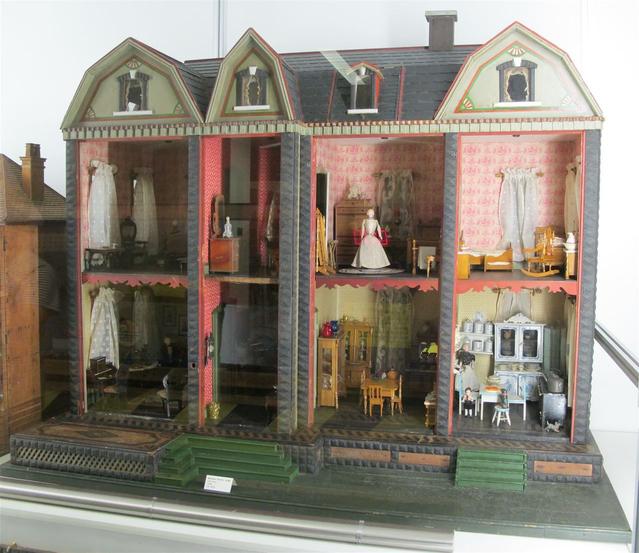Best dollhouses including one on display at Hampton’s Tuck Museum
Every child dreams of a dollhouse to let their imagination run wild. Not a way to escape from the real world but rather a way to engage, question, confront and consider the world. A dollhouse helps you realize that it is OK to play and dream.
The Hampton Historical Society and the Tuck Museum of Hampton History has on display a dollhouse from longtime Hampton resident Priscilla Emery Walker.
Priscilla grew up in Hampton and graduated from Hampton Academy in 1940. She lived most of her life on Mill Road where her family ran Emery the Florist at 1 Emery Lane in Hampton. Today at 98 years old, Priscilla resides at a nursing home in Dover.
Priscilla’s niece, Wanda Brower, says about Priscilla’s dollhouse: “she did all the work herself on the dollhouse, ordering wallpaper, furniture and other items from dollhouse miniature catalogs.”
The dollhouse is a real gem containing ten rooms, each intricately furnished with furniture, bedding, curtains and all the pieces that make a house a home.
In the kitchen a person sits in a chair with a pair of L.L. Bean boots nearby, on the side of the kitchen sink is a breadboard with “Priscilla” written on it. From the ceiling hangs a coiled strip of flypaper and on the floor a mouse scampers past curious puppies. So many details in each room, it has to be seen to be appreciated.
'Sunnyside' dollhouse and the Marelli's dollhouse
Another dollhouse in the New Hampshire Seacoast, in design, is very similar to Priscilla’s dollhouse and deserves recognition. The Hampton Falls Historical Society purchased in 2010 a partial replica of the full-scale homestead “Sunnyside,” constructed in 1878 for Hampton Falls residents Warren and Sarah Brown on Brown Road.
Descendents of the Brown’s- Lois Brown Perfect, Jeremy Perfect, Suzanne Perfect and Crowell Lewin- collaborated to build the dollhouse that now is on display in the Hampton Falls Historical Society Museum.
One other dollhouse to see in the Seacoast resides in the Marelli Gallery at the “Candy Store.” The dollhouse from the 1950s is not as ornate as the other two dollhouses with just four rooms with simple furniture and rugs and bedding made by Jeanne Marelli Raynes. Still, the dollhouse incites curious visitors to peek in the windows and open the door to see what is inside.

Famous dollhouses throughout the world
Dollhouses have been a part of a child’s growing up for many years. In 16th century Europe, only the wealthy would have a dollhouse, called “Baby Houses” or “Cabinet Houses.” They were on display to show success and status in society, usually a replica of their home. Probably no child at the time would dare play with these dollhouses.
Folding cardboard dollhouses that were lightweight and easy to ship with cardboard furniture were made by McLoughlin Brothers in 1894 in the USA.
In the Montgomery Ward catalog of 1903 was advertised “The Dolly Playhouse,” a pretty village, easy to assemble. It was not until after WWII that dollhouses were mass-produced and became affordable, made of metal with plastic furniture.
The largest and most expensive dollhouse is the "Astolat Dollhouse." It is said to be a dream world, with parquet floors, gold chandeliers, stained glass panels and a Wizard’s Tower. “Astolat” was a fantasy castle in Alfred Tennyson’s poem “Lady of Shalott.” The estimated value of the dollhouse is 8.5 million dollars. The last time the dollhouse was on display was in 2015.
Keepers of the light:Hampton’s lighthouse keepers from a bygone era
Another famous dollhouse is Queen Mary’s dollhouse, on display today in a public room in Windsor Castle in the United Kingdom. The dollhouse was built in 1921 for Queen Mary, the wife of King George V. It has hot and cold running water, electricity and King and Queen-like furnishings.
Historically Speaking:Hampton and the American Revolution
My favorite dollhouses in history are those of society matron Frances Glessner Lee. She had an antique business in New Hampshire, with her daughter and often summered at her family estate “The Rocks” in Bethlehem. When she retired, she began to create 20 crime scenes in dollhouses called “Nutshell Studies of Unexplained Death.” She featured her dollhouses in training seminars for homicide detectives at Harvard in the 1940s. She was called the “Godmother of Forensic Science.”
Tuck Museum’s resident photographer Rich Hureau has meticulously photographed each room of “Priscilla’s Dollhouse” but the best way to appreciate the dollhouse dwelling is to see it in person.
The Tuck Museum will be open till Friday, Dec. 17, 2021, reopening March 30, 2022, when the dollhouse will be on display for all to enjoy along with other exhibits about Hampton history.
The motto of the National Association of Miniature Enthusiasts is: “Only through sharing can we really enjoy our treasures.”
Thank you, Priscilla for sharing your dollhouse treasure.
Karen Raynes is a member of the town’s Historical Society.







